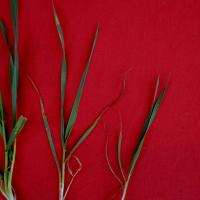Diagnosing phosphorus deficiency in wheat
Nearly all soils in Western Australia are phosphorus deficient in their natural state but the continual use of phosphorus fertiliser means acute deficiency in broadacre crops is rare, with the exception of Darling Range gravels. Induced phosphorus deficiency in seedlings can occur in very dry conditions, but is often transitory and plants recover when the topsoil rewets. Symptoms of phosphorus deficiency in wheat are usually non-specific and difficult to diagnose in the field. The most noticeable feature of phosphorus deficiency in wheat is reduced growth and vigour.
What to look for
- Smaller, lighter green plants with necrotic leaf tips, generally on sandier parts of the paddock or between header or swathe rows.
- Plants look unusually water-stressed despite adequate environmental conditions.
- Affected areas are more susceptible to leaf diseases.
Paddock
- In early development, usually in cases of induced phosphorus deficiency, seedlings appear to be pale olive green and wilted.
- On older leaves, chlorosis starts at the tip and moves down the leaf on a front, while the base of the leaf and the rest of the plant remains dark green. Unlike nitrogen deficiency, necrosis (death) of these chlorotic (pale) areas is fairly rapid, with the tip becoming orange to dark brown and shrivelling, while the remainder turns yellow. At this stage the second leaf has taken on the early symptoms of phosphorus deficiency.
- By tillering, (uncommon) symptoms of severe deficiency are dull dark green leaves with slight mottling of the oldest leaf.
Plant
What else could it be
| Condition | Similarities | Differences |
|---|---|---|
| Diagnosing nitrogen deficiency in wheat | Small less tillered and light green plants | Phosphorus deficient plants are thinner with darker leaves and older leaf tip death without leaf yellowing. |
| Diagnosing molybdenum deficiency in cereals | Small less tillered and light green plants | Phosphorus deficient plants are thinner with darker leaves and older leaf tip death without leaf yellowing. |
| Diagnosing potassium deficiency in wheat | Small less tillered and light green plants | Phosphorus deficient plants are thinner with darker leaves and older leaf tip death without leaf yellowing. |
Where does it occur?

Dry conditions
- Dry topsoil can induce phosphorus deficiency in young plants, but symptoms disappear when the soil rewets.
- Water repellent and acidic soils require more phosphorus.
- Phosphorus deficiency is a problem on high phosphorus-retaining soils, particularly in the Darling Range where soil acidity and water repellence markedly reduce phosphorus uptake.
Management strategies
- Plants have a high requirement for phosphorus during early growth. As phosphorus is relatively immobile in the soil, topdressed or sprayed fertiliser cannot supply enough to correct a deficiency.
- Phosphorus does leach on very low PBI (a measure of phosphorus retention) sands, particularly on coastal plains. Topdressing is effective on these soils.
How can it be monitored?

Soil test

Tissue test
- Soil test to determine phosphorus fertiliser requirements. Soil tests may underestimate available phosphorus on very low PBI sands and overestimate it on acidic and water repellent soils (particularly in the Darling Range).
- Use whole-top plant test to diagnose suspected phosphorus deficiency, and compare paired good/poor plant samples where possible.
See also
Further information
Where to go for expert help
Page last updated: Monday, 27 February 2017 - 12:35pm




